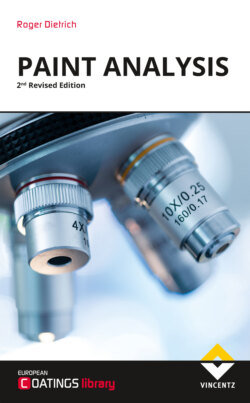Читать книгу Paint Analysis - Roger Dietrich - Страница 29
На сайте Литреса книга снята с продажи.
13.2.1.1 Example 1: Bernoulli experiment
ОглавлениеA paint shop provides high quality decorative coatings for automotive interior parts. After finishing thousands of coated parts, it was found that 1 in 500 parts exhibits a paint defect. It is assumed that poor raw part quality might be the reason for the coating failure. Therefore, a sampling of the next lot of raw parts has been planned to find out if the lot (which consists of thousands of raw parts) contains defective parts.
The question is: Which sample size is needed to make sure that one or more defective parts can be found with a confidence level (or confidence interval) of 98.2 %?
The confidence interval defines the range which includes the true parameter of an experiment that is repeated infinitely, within a certain probability (here 98.2 %). For this example, it means that the sample size has to have a minimum size which guarantees with a probability of 98.2 % that at least one or more defective samples will be found. Well, there is no intuitive way to find out the necessary sample size. This question has to be looked at by statistic methods.
Generally speaking, this is a random experiment which allows for two results (defective and not defective) which is also called a Bernoulli experiment. A Bernoulli experiment which is repeated n-times is called a Bernoulli chain [4] [5] . We are looking for the number n of independent trials with a pass or fail outcome of each trial (which means defective part or non-defective part) which are necessary to pull out at least one defective part with a confidence level of 98.2 %.
If the result of this Bernoulli experiment follows a binomial distribution and the trials (single sampling) do not alter the population (the total number of parts to be tested) the following notation applies:
X = number of successes of the binomial experiment
n = number of trials
p = the probability of success on an individual trial
P = the binomial probability that an n-trial binomial experiment results in exactly X successes, when the probability of success on an individual trial is p
Suppose that, for this experiment the probability of success on an individual trial p is 1 in 500 parts = 0.2 % = 0.002
The desired probability P for “at least one defective part” is: 0.982 or 98.2 %
P(X ≥ 1) ≥ 0.982
in other “words”
1 − P(X = 0) ≥ 0.982 or
− P(X = 0) ≥ − 0.018
P(X = 0) ≤ 0.018
With the formula for binomial distributions:
P(X = k) = n k * p k * (1 − p) n−k
this leads to
( n 0 n 0)* 0.002 0 * (1 − 0.002) n−0 ≤ 0.018
(0.998) n ≤ 0.018
ln ((0.998) n) ≤ ln (0.018)
n * ln0.998 ≤ 0.018
| n ≥ l n ( 0.018 ) l n ( 0.998 ) n ≥ 2006.68 |
Fortunately this calculation can be approximated by a more “handy” equation [6] shown in Table II.3.
| Table II.3: Approximation for different confidence levels by the “rule of three σ [7] | |
| Confidence level | Worst case risk |
| 86.5 % | 2/n |
| 95 % | 3/n |
| 98.2 % | 4/n |
| 99.3 % | 5/n |
For a confidence level of 98.2 % the worst-case risk following the “rule of three σ" [6] can be approximated by
| p = 4 n |
which means solving for
| n = 4 p |
That
| n = 4 0.002 p ≥ 2000 |
So at least 2000 samples have to be randomly inspected to ensure with a confidence level of 98.2 % that at least one defective part is captured.
Taking into account that a paint defect (like e.g. a crater, a bubble or a speck) is a local effect which does not necessarily affect the whole part, this mathematical result means that 2000 parts would have to be tested examining the whole surface (because in most cases you cannot figure out where the defect area of a raw part is by visual inspection).
Here is the practical (but discouraging) answer: This is not possible! A testing of this size is not reasonable!
It has to be mentioned that the above mentioned formula is only valid for randomly selected samples with defects randomly distributed through the population under investigation.
